The Care and Maintenance of Cotswold stone
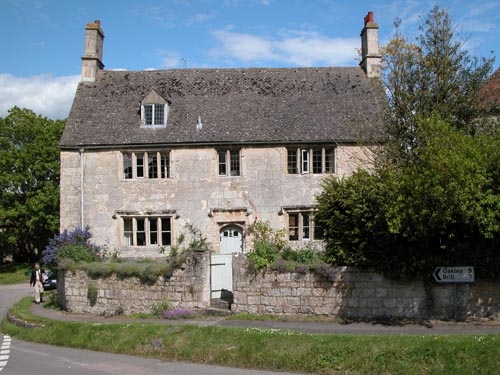 "What attracts us to the rural idyll of the Cotswolds?" Asks Martin Hall of Hall and Ensom.
"What attracts us to the rural idyll of the Cotswolds?" Asks Martin Hall of Hall and Ensom.
Even in these difficult market conditions the attraction of a stone cottage in this beautiful countryside is hard to resist. The stone buildings in the Cotswolds embody the best English traditions of craftsmanship and ordered beauty. Nothing gives our landscape such richness, individuality and charm as the local building materials.
From the brown ironstones of north Oxfordshire and the greyer stones of north Gloucestershire, through to the honey coloured stones of south Gloucestershire, the essential quality of the Cotswolds is its limestone.
This is used to such pleasing effect in what is referred to as random rubble masonry seen throughout our vernacular buildings in this area. Roofs may be thatched, Welsh slate, concrete or natural tile but where the natural stone slates of the area - Guiting and Stonesfield - are used, these really add to the charm of the local buildings.
It was very common for each village to have had its own quarry. Some, such as Headington, became famous in their own right and exported stone throughout the land, and was in use from early medieval times right through to the mid-19th century and was used extensively by the Oxford colleges.
Also well known is Tainton stone, but Burford, Stow, Clipsham, Bladon, Long Hanborough all have local quarries in the surrounding villages. Stone was generally used locally as transport costs were high and roads poor. Even distinguished buildings such as Blenheim Palace suffered from transport difficulties, and a local quarry was found to reduce the high cost of carting to Blenheim. Of course some stone was better than others but the quality would vary even from seam to seam in an individual quarry. Some stone was more useful for some purposes than others; the prime example being Stonesfield, where the stone was much more suited to roofing slates than building stone and indeed was more valuable as a result. Poor quality stone would be used for field boundaries which also gives the countryside the character so much beloved of this area.
Most of the cottages we admire in the Cotswolds date from the building boom of the late 17th and 18th centuries, caused by an agricultural population rise. The arrival of canals and later, railways, encouraged greater movement and there followed a decline in the rural population.
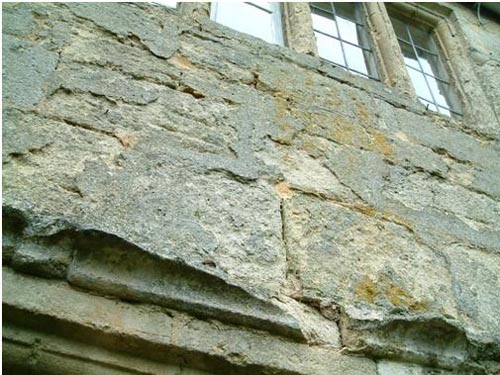 Even stone decays over time. Cotswold stone is a limestone and is therefore alkaline. It is affected by pollution often referred to as acid rain, which has historically been one of the main sources of decay to any limestone construction. It predominantly affects ashlar, smooth dressed stone and range work - a cheaper form of dressed ashlar - where the surface of the stonework decays due to chemical change and forms a dirty crust of sulphate. Nowadays this crust tends to consist of nitrates caused by fumes from diesel particulates, but originally it was due to the proliferation of coal and wood fires. This black staining is visible wherever walls were more sheltered and the rain couldn’t wash the pollution away.
Even stone decays over time. Cotswold stone is a limestone and is therefore alkaline. It is affected by pollution often referred to as acid rain, which has historically been one of the main sources of decay to any limestone construction. It predominantly affects ashlar, smooth dressed stone and range work - a cheaper form of dressed ashlar - where the surface of the stonework decays due to chemical change and forms a dirty crust of sulphate. Nowadays this crust tends to consist of nitrates caused by fumes from diesel particulates, but originally it was due to the proliferation of coal and wood fires. This black staining is visible wherever walls were more sheltered and the rain couldn’t wash the pollution away.
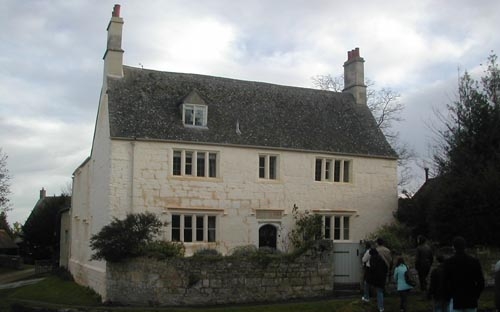 Many cottages were originally protected by a coating of limewash. This is a dilution of calcium hydroxide mixed with pigment and other additives such as linseed oil, tallow and animal fat. It is often still possible to see traces of this on many Cotswold cottages, especially at the underside of roofs at eaves level where it has been protected. This lime-wash was applied at regular intervals and helps to protect the stone from decay; it was in effect the skin over the skeleton of stone. However, fashion and a shortage of labour after the First World War caused this technique to fall into disuse and we now see the buildings exposed with their skeleton of stone rather than limewashed in a variety of colours, as they would have been. This has exposed a lot of stonework to weathering and decay over the last 100 years where it would otherwise have been better protected. We have recently seen a resurgence of limewashing and have ourselves used it to reduce the necessity for large scale stonework repairs. (See photograph).
Many cottages were originally protected by a coating of limewash. This is a dilution of calcium hydroxide mixed with pigment and other additives such as linseed oil, tallow and animal fat. It is often still possible to see traces of this on many Cotswold cottages, especially at the underside of roofs at eaves level where it has been protected. This lime-wash was applied at regular intervals and helps to protect the stone from decay; it was in effect the skin over the skeleton of stone. However, fashion and a shortage of labour after the First World War caused this technique to fall into disuse and we now see the buildings exposed with their skeleton of stone rather than limewashed in a variety of colours, as they would have been. This has exposed a lot of stonework to weathering and decay over the last 100 years where it would otherwise have been better protected. We have recently seen a resurgence of limewashing and have ourselves used it to reduce the necessity for large scale stonework repairs. (See photograph).
Another one of the main issues with stone cottages is the type of pointing and re-pointing commonly used. Up until the First World War all these houses were built in lime mortar. This was often little more than local mud, sand and burnt limestone without ever using any cement. Cement wasn’t “re-invented” until the 1870’s when it started to become more generally used because it set so much quicker and it enabled people to build faster. However, unfortunately nearly every Cotswold cottage that I come across has been re-pointed in hard, dense, cement mortar, often with a rather terrible ribbon detailing beloved by some but hated by most and now it is, of course, so difficult to remove without damaging the stonework.
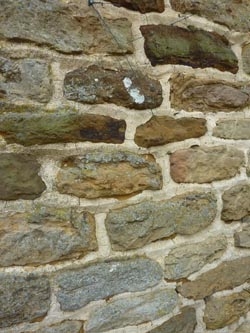 Limestone will decay ten times quicker if cement mortar pointing is present. Water cannot evaporate so easily out of the mortar and is concentrated in the stonework. If this stonework is at all weak and unfortunately, much of the local stone work is, or if the pore size is particularly small it is susceptible to spalling – flaking of the surface. Most of the limestone in this area is referred to as oolitic and has a very small pore size and it sometimes can decay quite quickly. (See photographs). At this point re-surfacing an expensive stonework replacement is usually the only course of action – unless of course limewashing is adopted. Often I see reports where recommendations are made to re-point. This is rarely necessary, and if so, usually only in very small areas. So before undertaking any re-pointing, stop and say ”does anything really need to be done?”
Limestone will decay ten times quicker if cement mortar pointing is present. Water cannot evaporate so easily out of the mortar and is concentrated in the stonework. If this stonework is at all weak and unfortunately, much of the local stone work is, or if the pore size is particularly small it is susceptible to spalling – flaking of the surface. Most of the limestone in this area is referred to as oolitic and has a very small pore size and it sometimes can decay quite quickly. (See photographs). At this point re-surfacing an expensive stonework replacement is usually the only course of action – unless of course limewashing is adopted. Often I see reports where recommendations are made to re-point. This is rarely necessary, and if so, usually only in very small areas. So before undertaking any re-pointing, stop and say ”does anything really need to be done?”
A recent case of a building society surveyor holding back a retention until the property was re-pointed proved to be, in the main, completely unnecessary. Never wholesale re-point a cottage. Pointing contains a multitude of information about the history of the cottage. Old blocked up doors and windows can be revealed in changes in pointing style, technique and colour. It is always important to take samples and try and match if possible to replicate the type of pointing used. However, a good general mix is one part non-hydraulic lime putty to two/two and a half parts of coarse aggregate, not the smooth builder’s sand but a mixture of coarse and fine sand, so that the overall effect is gritty and has texture, colour and is alive with the aggregate finish on the surface. So often this is brushed with a wire brush producing regular lines on the surface but this should not be done and more care needs to be taken in the finish to pointing. Pointing should always be slightly recessed from the surface of the stone unless of course you want to apply lime wash to the wall, in which case a flatter surface, almost buttered over the stonework is required to give a smoother uniform appearance.
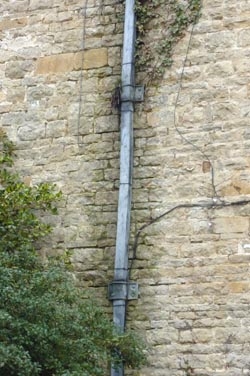 Stonework needs protection and a good roof overhang will provide this. Thatch gives the best protection, overhanging by as much as 2-3 feet in some cases. However, many roofs have tiles and stone slates - here is an example of what can happen when a gutter has been allowed to leak for over 20 years. For a £10 repair there is now a £2,000 repair bill. In this case this is even after an earlier repair which would have probably cost at least £1,000 and all because the gutter wasn’t fixed. In this case the leaking gutter caused water to penetrate through the wall into the end of an oak beam supporting the floor, and as a result death-watch beetle became established. Death-watch beetle doesn’t like dry timber and often accompanies fungal decay. The end of the beam decayed and a corbel* was introduced into the wall to support the remainder of the beam. However, the gutter still continued to leak and now the stonework on the front wall is damaged, after the frosts of the last two severe winters, and needs replacement. The end of the oak beam continued to get wet, is now affected by death-watch beetle to an even greater extent, and the end needs to be repaired by splicing in a new section of timber at a cost of at least £2,000, all for the sake of a leaking gutter.
Stonework needs protection and a good roof overhang will provide this. Thatch gives the best protection, overhanging by as much as 2-3 feet in some cases. However, many roofs have tiles and stone slates - here is an example of what can happen when a gutter has been allowed to leak for over 20 years. For a £10 repair there is now a £2,000 repair bill. In this case this is even after an earlier repair which would have probably cost at least £1,000 and all because the gutter wasn’t fixed. In this case the leaking gutter caused water to penetrate through the wall into the end of an oak beam supporting the floor, and as a result death-watch beetle became established. Death-watch beetle doesn’t like dry timber and often accompanies fungal decay. The end of the beam decayed and a corbel* was introduced into the wall to support the remainder of the beam. However, the gutter still continued to leak and now the stonework on the front wall is damaged, after the frosts of the last two severe winters, and needs replacement. The end of the oak beam continued to get wet, is now affected by death-watch beetle to an even greater extent, and the end needs to be repaired by splicing in a new section of timber at a cost of at least £2,000, all for the sake of a leaking gutter.
In part two we will consider some of the other problems affecting stone walls, parapet gutters, parapets themselves, rising dampness - “myth or fact?” and how one can overcome these problems using traditional techniques.
For further information visit www.hallandensom.co.uk















